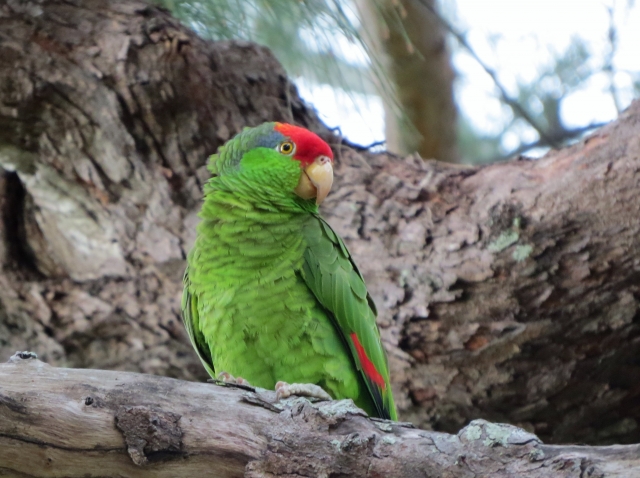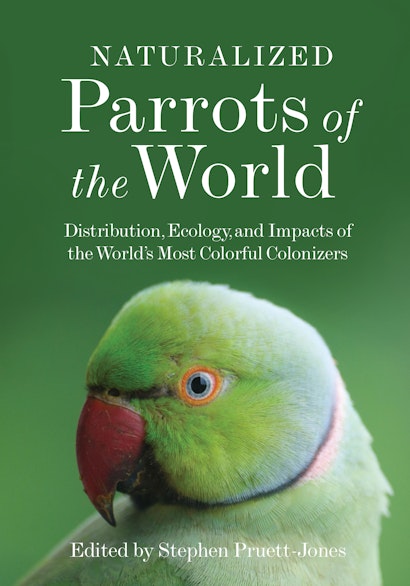There are more than 350 species of parrots in the world, and approximately 300 of these species have been transported to other countries through the caged pet trade. Whether through escaped captivity or purposeful release, many of these parrots are now breeding in new habitats. Indeed, no less than 75 species of parrots have established breeding populations in countries where they were introduced, and parrots are now among the most widely distributed group of birds. Naturalized Parrots of the World is the first book to examine this specific avian population.
Naturalized Parrots of the World is an intriguing title, but exactly what are ‘naturalized’ parrots?
SP-J: As an introduction, parrots and humans have had a long and complex history of interactions. Whether as status symbols, or as gifts to rulers, or as pets, parrots have been carried and traded by humans around the globe for at least 2,500 years. This trade has increased dramatically over the last 50 years and unfortunately continues today. When captive parrots are moved to new areas, sometimes they escape and sometimes they are purposefully released. It’s hard to imagine why someone who pays hundreds or thousands of dollars for a pet parrot would let it go, but it happens. Once in the wild, if enough parrots of the same species find each other, they may begin breeding in the new area. And, lastly, if this population increases and becomes stable it would be called naturalized. In other words, naturalized parrots are introduced parrots that have established a stable population in a new habitat. The same term—naturalized—can refer to any introduced and established species, plant or animal.
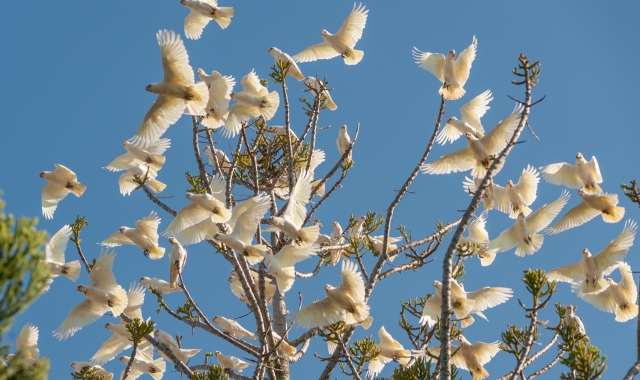
Isn’t it strange and hard to imagine that pet owners release parrots?
SP-J: Yes, it is, but it happens. If someone buying a parrot ends up with a bird caught as an adult in the wild, such birds are very difficult to train and may also be very noisy. I can imagine where people simply don’t know how to train a bird and get frustrated and let it go. But, besides pet owners releasing parrots into the wild, sometimes birds escape or are accidentally released. There are many stories in urban legend about how captive parrots have escaped captivity. Monk Parakeets are now common in the United States and they began breeding in multiple cities around the country in the late 1960s. There is a legend in New York that a crate of captive Monk Parakeets destined for the pet trade was being unloaded at JFK airport and the crate fell off the loader, broke, and hundreds of parakeets flew off into the sunset, eventually to become breeding residents in New York. There is another story that an airport worker liked the parakeets and didn’t like seeing them in cages, and so he purposefully broke a large crate with birds destined for pet stores. Just as Monk Parakeets are common in the United States, the Rose-ringed Parakeet in common in the United Kingdom. There are multiple stories about how rose-rings were released in England, most of them unfounded but nevertheless interesting. One of those is that birds escaped from Isleworth Studies in London in 1951 during the filming there of the movie African Queen with Humphrey Bogart and Katherina Hepburn. I now want to re-watch that movie and see if there were Rose-ringed Parakeets in some scenes. A second story is that Jimi Hendrix released a pair of parakeets in Carnaby Street in London in the 1960s although it is not clear why Jimi Hendrix would have had the birds in the first place, or why he would release them. Maybe he thought their colors were psychedelic? Regardless of the accuracy of these stories, parrots in large cities attract a lot of attention and obvious interest and speculation.
How many species are we talking about? How many naturalized parrots are there?
SP-J: There are approximately 380 species of parrots in the world. ‘Approximately’ meaning that biologists don’t always agree on the naming of certain species. But, of these 380 or so species, the vast majority, well over 85% have been transported around the world in trade activities. So, about 330 species of parrots have been taken out of the wild, millions and millions of individuals, and moved to new areas, new habitats. Of these species, more than half have been seen living in the wild in the new area, and upwards of 70+ species have been documented as breeding in the new area. Thus, about 20% or one fifth of all parrot species in the world have breeding populations outside of their native range.
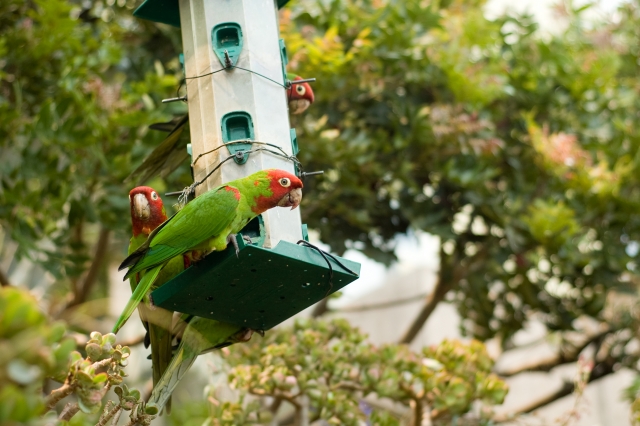
Have all parrots in the pet trade been seen in the wild in their new habitats?
SP-J: Not all, but many species have. In some countries, the United States for example, which has been the biggest importer of captive parrots though history, almost 100 species of parrots have been seen living in the wild. Also, a recent study by one of my former undergraduate students, Jenny Uehling, showed that in the continental United States, there are now 25 species of breeding parrots in 23 different states. To me, this is amazing. The continental USA originally had two native species of parrots, the Carolina Parakeet and Thick-billed Parrot, both of which are now extinct. The Carolina Parakeet is completely extinct and the Thick-billed Parrot is extinct in the USA. Nevertheless, we now have 25 different species of parrots breeding on the mainland. How and why they got here, how they are surviving and thriving, and how they are interacting with both other bird species and with humans is one of the general topics of this collection of articles.
Well, hang on, introduced species are considered ‘bad’. Are naturalized parrots bad?
SP-J: This question is why I find naturalized parrots so interesting and it is why I have been captivated with this group of birds since the late 1980s, when I first saw Monk Parakeets in Hyde Park Chicago. Introduced and naturalized species will often increase in numbers and distribution, and they can sometimes cause real harm to other species or to human infrastructure or economy. In such cases, the introduced species would be called invasive. Are naturalized parrots invasive? In a few localities, some species have caused economic harm. As an example of impacts, the Monk Parakeet likes to build its nest on electrical utility structures and these nests can cause electrical shorts, power outages, and fires. In countries where monk parakeets are common, local utility companies spend considerable effort and money dealing with the problem of parakeet nests. There are also a few documented cases of other parrots displacing native species of birds from their nests and the Rose-ringed Parakeet has been observed killing native bats, presumably because the bats were using a nesting site as a roosting cavity.
So, yes, there are some documented cases of naturalized parrots causing harm or economic loss. Nevertheless, these impacts are localized and only involve one or two species of parrots. The vast majority of naturalized parrots are not known to have any negative impacts. Careful economic analyses suggest that naturalized parrots should not be considered invasive in terms of their impacts.
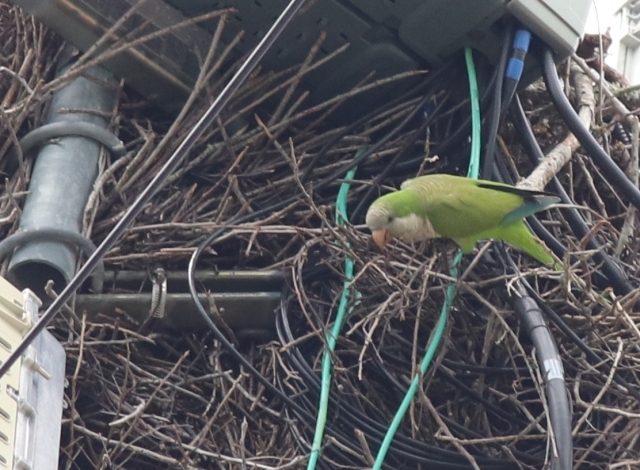
You mentioned that you first saw Monk Parakeets in Chicago. Was this your first sighting of introduced parrots?
Sort of, but not really. I did my graduate work at University of California, Berkeley in the 1980s. I had heard stories of the ‘Parrots of Telegraph Hill’ across the bay in San Francisco but I never drove over to the city to see them. I guess I thought they were an anomaly. Then I did a postdoctoral position in San Diego and often saw wild parrots there, although I couldn’t identify them to species. But, when I moved to Chicago to begin my position at University of Chicago, everything clicked. I saw Monk Parakeets there and was fascinated. I also realized that no one was researching them, and so over the years I’ve had many undergraduate students complete their thesis projects on the local parakeets. It’s been a rewarding experience for me to live in a city that has a large population of Monk Parakeets and to be able to observe and study them.
Back to the question of impacts, are naturalized parrots generally left alone around the world?
SP-J: In most cases, yes. But, there are a couple of big exceptions. When Monk Parakeets cause damage to electrical infrastructure, utility companies will remove nests. They really have to. The nests of Monk Parakeets can and do cause power outages and electrical fires. Also, in some areas, where numbers of parakeets have increased dramatically, people have sought to reduce their numbers. This is happening now in Barcelona Spain, where the government is attempting to remove (ethically cull is the phrase) up to 12,000 Monk Parakeets. This is a large number, but in Barcelona there may be upwards of 40,000 parakeets. It shouldn’t surprise you that this effort is very controversial and many groups are working to stop these actions.
Are there any positive impacts of naturalized parrots?
SP-J: Absolutely. Naturalized parrots can have positive impacts in a number of ways. Because of their visibility, bright colors, and beauty naturalized parrots often get people interested in bird watching, learning about nature, conservation, and the negative impacts of the pet trade and wildlife trade in general. In many cities, naturalized parrots are a tourist attraction, and in New York one can even join the Parakeet Safari, where a bus will take you around to see the nests of the Monk Parakeet. Naturalized parrots are very important in terms of conservation. Many species of parrots are endangered or threatened in their native ranges. In some cases, the numbers of birds in naturalized population can be as large as the number of birds in the native range. Thus, the naturalized population may actually serve as a critical reservoir for survival of the species. In situations with endangered species, naturalized populations could serve as the source of birds for reintroductions into the wild, captive breeding programs, etc. Lastly, it is often the case that study of naturalized populations is easier than the study of the birds in the native range. In this case, research in the naturalized area can shed light on aspects of natural history, behavior, and ecology in species that are sometimes almost impossible to study otherwise.
This book contains article by researchers around the world. Are naturalized parrots everywhere?
SP-J: Naturalized parrots are now found on every continent except Antarctica. Introduced parrots have been recorded in the wild in at least 200 different countries, and naturalized species are known in 86 countries. The average person may not see parrots on a daily basis, but parrots are really common in some areas. and becoming more common. In Florida, for example, there are so many species of naturalized parrots that there is even a field guide to the parrots of south Florida. One of the reasons I wanted to involve researchers from around the world is to highlight the different perspectives on naturalized parrots in different countries, and to highlight the unique histories of establishment of parrots in some cases.
As one example, in the United States the 25 naturalized parrot species are from South America, Africa, or Australia. In contrast, in Australia there is a roughly similar number of naturalized parrot species but most of them are native to Australia itself. How can a country have a species that is both native and naturalized? That’s because these species have been taken from their native range, transported elsewhere within Australia and, again, have either escaped or been released. Even if a species is native to a given country, if it is transported out of its native area and establishes a new population elsewhere it would be considered naturalized. For Australia, it is also interesting that non-Australian species have generally been unsuccessful at establishing naturalized populations, perhaps because of the large diversity of native parrots already present there.
Australia also highlights an increasingly common phenomenon with parrots, and that is the urbanization of wild species. Many species of animals, parrots included, are adapting themselves to human-modified environments and are not only succeeding there, but really thriving. This is true not just in Australia, but in many cities in Central and South America as well. And in these cases, abundant urbanized native parrots are presently the same challenges and opportunities as are naturalized species.
Lastly, what do you think is the future for naturalized parrots?
SP-J: One of the motivations behind this book was to make people aware of naturalized parrots and to establish a sort of baseline research on which future work can build. Naturalized parrots are becoming more common in areas where they occur now, the number of areas where they are established is increasing, and their importance in highlighting the plight of native parrots in the wild is also increasing. I hope that the future of naturalized parrots is that they play a role in the conservation of parrots in their native ranges, and they may do this in a myriad of ways. It seems certain that their numbers will increase, and perhaps the awareness of them by society and the research on them by biologists will also increase.
Stephen Pruett-Jones is associate professor of ecology and evolution at the University of Chicago. He has spent forty-five years studying the biology and behavior of birds in North America, Australia, and Papua New Guinea.
